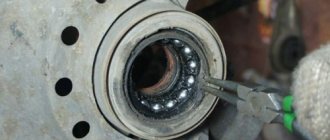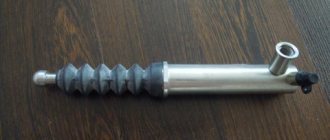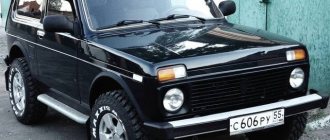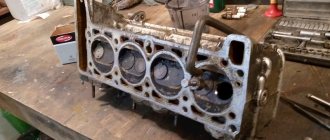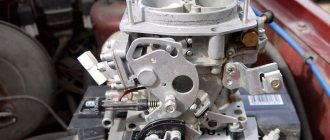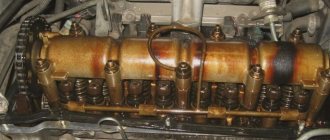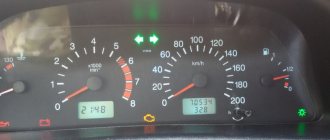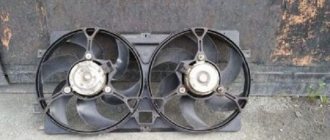How to determine the serviceability of a wheel bearing on a Lada 4×4?
Before replacing a bearing, you need to make sure it is faulty. One of the symptoms is a hum when driving on the highway, which changes when cornering. But the hubs on the Niva can be adjusted. If the car's mileage does not exceed 20-30 thousand kilometers, then the hub on the Chevrolet Niva simply needs to be adjusted. After several adjustments, adjustment is no longer acceptable and the faulty bearing must be replaced.
How to determine its malfunction? It is enough to do the following:
- Hang up the wheel.
- Grab the wheel with both hands and swing it in a vertical plane. Large play is a sign of a malfunction.
- Spin the wheel by hand. It should spin for a while without making a sound. The presence of extraneous noise is a sign of a problem.
Which bearing to choose?
The best wheel bearings for the Chevrolet Niva and short Niva can be selected from the list below:
- FINWHALE - price 450 rubles;
- AVTOVAZ - price 350 rubles;
- KOYO - price 800 rubles;
Also good companies are SKF and SNR.
Adjustable bearings should not be confused with the new type of double row bearings. They are different in width, price and article number. The catalog number of the wheel bearing on Niva is 2121310302010 . This number is the adjustable bearing.
Choosing a new bearing.
A new part is selected based on the conditions in which the car will be used. For most situations, Niva 2121 bearings manufactured at the VAZ plant are suitable. If the car is used mainly for off-road driving, it is better to use more durable elements. Parts produced by Triali have very good performance.
During production, this vehicle is equipped with double-row bearings. They have a longer service life and do not require additional lubrication.
How to replace front bearings on a Chevrolet Niva?
To perform this procedure, you must complete the following procedures:
- Hang up and remove the front wheel of the car. Also remove the protective cap of the hub nut:
2. Unscrew the nut 27 of the wheel bearing and unscrew it:
3. To prevent the hub from turning, you can fix it with a mounting tool:
4. Remove the brake caliper. To do this, you must first remove the pads. Then unscrew the caliper bracket and remove it. The caliper itself with the pistons can be suspended on a suspension spring or any other element. The main thing is not to damage the hoses:
5. Remove the hub with the brake disc:
6. Remove the cotter pin of the steering end nut:
7. Unscrew the nut 22 securing the steering tip to the steering knuckle:
8. Applying light blows to the tip and eye, knock it off the steering knuckle. Or use a puller:
9. We knock the ball joints off the steering knuckle. How to do this is described here. After this, take out the steering knuckle and remove the outer oil seal from the bearing:
10. Remove the thrust ring:
11. We take out the bearing itself:
12. We install a cylindrical stop under the steering knuckle, larger in diameter than the hub bearing on the Niva.
13. Knock out the bearing with a drift:
The photo below shows where the drift rests to remove the outer race of the Lada 4×4 wheel bearing:
15. Clean the old seat from dirt and rust. Press in the new bearing race. You can use the clip of an old part as a mandrel. To do this, you can clamp the parts in a vice and gradually press the part inside the steering knuckle or use a press:
You can use another mandrel:
16. The pressed-in clip looks like this:
17. Lubricate the holder well with lithol:
18. Lubricate the wheel bearing well with a portion of lithol and place it on the outer race:
19. Reassemble all the elements in the reverse order: install the steering knuckle on the Niva, secure the ball joints, steering end and caliper. Adjust the new bearing. This procedure is mandatory!
Generator bearing: replacement recommendations
The following recommendations are given for replacing the Niva Chevrolet generator bearing:
- The first step is to remove the generator itself. First, the generator mounts are loosened, then the adjustment bolt is released. The next steps are to remove the belt and disconnect the ground from the battery. We are talking about the negative terminal. It is also necessary to disconnect the wires from the generator itself. The structure is removed through the lower part. Why does the mount itself unscrew?
- After this, the master begins to disassemble the generator. The first step is to remove the pulley. The owner will need a screwdriver to lock the rotor. The main thing is a careful approach to work. The pulley is unscrewed with the appropriate key. You will need to pull back the latches to remove the cover. The part is pulled towards itself. All connections with bolts are additionally processed. Then it will be easier to unscrew them.
- The next steps are to unscrew the screws and remove the voltage regulator unit. You also need to get rid of brushes for a while. The generator cover is disconnected from the starter, otherwise it will not be possible to gain access to the bearings themselves. The main thing is not to damage the winding during such work.
- After complete disassembly of the generator, access to the bearings becomes available. It remains to check the parts for any defects that have appeared, including cracks and chips. Do the parts rotate easily? Is there any play between them? The seats may suffer from wear, so they also need to be inspected.
- Next, you need to knock the bearing out of its seat. To do this, tap the surface with a small hammer. The blows must be strong, but careful, otherwise the result will not be achieved. A piece of pipe of the appropriate size will make an excellent stand. Removing the rear bearings is impossible unless a special puller is used.
- The properties of old and new parts must remain similar. The same attachment is used when pressing into the body. The anchor is where the rear bearing is installed.
- When reassembling, proceed in reverse order.
Below watch a video on how to disassemble and repair a Niva generator.
Adjusting the clearance in Niva hubs
After installing a new bearing, a new wheel nut should also be used. The wheel must be on the car.
Adjustment of the front hubs on the Niva and Chevy Niva is carried out as follows:
- Screw the hub nut all the way and loosen slightly.
- Checking the play. If it persists, tighten the nut.
- We check the play again.
- The procedure is carried out until the backlash disappears.
- Use a sledgehammer to break a tire or drive a Niva a couple of meters.
- A small backlash appears. We also tighten the nut and leave it barely noticeable.
- Now the nut can be tightened.
Attention! You should drive the car for one day, after which, adjust the bearing again.
This is how wheel bearings are replaced and adjusted on Niva 2121, 21213, 21214, 2123 and Lada 4×4.
Purpose and design of a wheel bearing
Bearings serve a dual function. On the one hand, they provide support for an axis, shaft or other element of rotation. On the other hand, they convert sliding friction into rolling friction. The wheel bearing is designed to ensure uniform rotation of the wheel hub. This is the connecting link between the hub and the axle of the car. Note that these elements ensure rotation of not only the front, but also the rear wheels.
Any bearing has the same basic structure:
- Outer ring (outer race);
- Inner ring (inner race);
- Guide for rolling elements (cage);
- Conical, cylindrical or spherical elements).
Bearings of modern imported cars have a more complex structure. Typically, their inner race is part of the hub, and the design itself contains electronic sensors. They are characterized by an increased service life. Russian manufacturers have not yet reached such technology, so they use simpler devices. On Chevrolet Niva cars, as on previous generations of the VAZ SUV, a pair of tapered bearings are installed on each hub.
Simplifying a unit negatively affects its reliability. Moving elements are especially sensitive to sharp impacts that chassis parts receive when driving over uneven surfaces.


